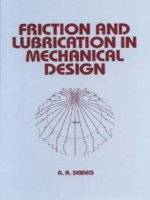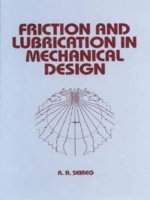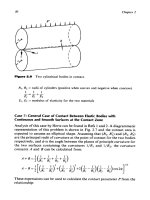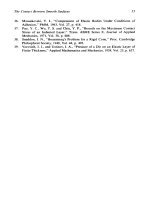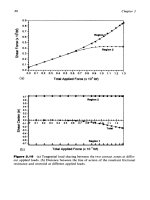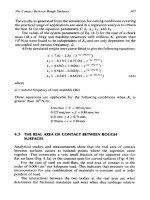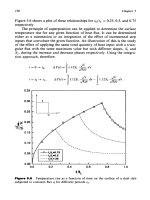Friction and Lubrication in Mechanical Design Episode 2 Part 1 potx
Bạn đang xem bản rút gọn của tài liệu. Xem và tải ngay bản đầy đủ của tài liệu tại đây (1.18 MB, 25 trang )
230
Chapter
6
line
XX
at
F1.
A
horizontal line
FIGl
is then drawn to meet the line
P*
=
500
at
G1.
The point
HI
vertically above
G1
gives the first approxima-
tion for
S*
to be
0.27.
This value of
S*
is then entered as point
I
in the second nomogram (Fig.
6.46b). Draw a vertical line
IJ
to meet the curve
LID
=
1. Then the hor-
izontal line
JK
meets
RCL/k
=
2.88
line at
K.
Point
L
is vertically below
point
K
and on the line
M/(T
+
t9)*
=
2.15.
The horizontal line
LMN
is
such that point
N
is vertically below point
I
and point
M
is on the
eve
axis.
Point
M
provides the new approximation for
P*
=
495 psi and point
N
gives
AT*
2
110"F(for
LID
=
1).
With
AT
=
1
lO"F,
the new entry point
A2
in the first nomogram (Fig.
6.46a) is determined and the procedure is continued.
After six iterations,
S*
=
0.16 can be accepted as the solution for the
considered example.
6.4
THERMOHYDRODYNAMIC LUBRICATION ANALYSIS
INCORPORATING THERMAL EXPANSION ACROSS THE
FILM
Viscosity is generally considered to be the single most important property of
lubricants, therefore, it represents the central parameter in all lubricant
analysis. By far the easiest approach to the question of viscosity variation
within a fluid film bearing
is
to adopt a representative or mean value visc-
osity. Examples of studies which have provided many suggestions for cal-
culations of the effective viscosity in a bearing analysis are presented By
Cameron [34] and Szeri [35]. When the temperature rise of the lubricant
across the bearing is small, bearing performance calculations are customa-
rily based on the classical, isoviscous theory. In other cases, where the
temperature rise across the bearing is significant, the classical theory loses
its usefulness for performance prediction. One of the early applications of
the energy equation to hydrodynamic lubrication was made by Cope [36] in
1948. His model was based on the assumptions of negligible temperature
variation across the film and negligible heat conduction within the lubrica-
tion film as well as into the adjacent solids. The consequence of the second
assumption
is
that both the bearing and the shaft are isothermal compo-
nents, and thus, all the generated heat is carried out by the lubricant.
As
indicated in a review paper by Szeri [37]: the belief, that the classical theory
on one hand, and Cope's adiabatic model on the other hand, bracket bear-
ing performance in lubrication analysis, was widely accepted for a while.
Design
of
Fluid Film
Bearings
23
I
In 1987, Pinkus
[38]
in his historical overview of the theory of hydro-
dynamic lubrication pointed out that one of the least understood and urgent
areas
of
research is that
of
thermohydrodynamics. In the discussion of
parallel surfaces and mixed lubrication, he indicated that the successful
operation of centrally pivoted thrust bearings cannot be explained by the
hydrodynamic theory. He backs
his
assertion by reviewing several failed
attempts to explain the pressure developed for bearings with constant film
thickness.
Braun et al.
[39-41]
investigated different aspects of the thermal effects in
the lubricant film and the thennohydrodynamic phenomena in a variety of
film situations and bearing configurations. Dowson et al.
[42,43]
adopted the
cavitation algorithm proposed by Elord and Adams and studied the lubri-
cant film rupture and reformation effects on grooved bearing performance
for a wide range of operating parameters. The comparison of their theore-
tical results and those presented in a design document revealed that a con-
sideration of more realistic flow conditions will not normally influence the
value of predicted load capacity significantly. However, the prediction
of
the
side leakage flow rate will be greatly affected if film reformation
is
not
included in the analysis. Braun et al.
[44]
also
experimentally investigated
the cavitation effects on bearing performance in an eccentric journal bearing.
Lebeck
[45, 461
summarized several well-documen ted experiments
of
parallel sliding or parallel surfaces. The experiments clearly show that as
speed is increased, the bearing surfaces are lifted such that asperity contact
and friction are reduced. He also suggested that the thermal density wedge,
viscosity wedge, microasperity and cavitation lubrication, asperity colli-
sions, and squeeze effects do not provide sufficient fluid pressure to be
considered a primary source of beneficial lubrication in parallel sliders.
Rohde and Oh
[47]
reported that the effect
of
elastic distortion
of
the bear-
ing surface due to temperature and pressure variations on the bearing per-
formance is small when compared with thermal effects on viscosity.
Most of analytical studies dealing with thermohydrodynamic lubrica-
tion utilize an explicit marching technique to solve the energy equation
[47,
481.
Such explicit schemes may in
some
situations cause numerical instabil-
ity.
Also, the effect of variation
of
viscosity across the fluid film on the
bearing performance was acknowledged to be an important factor in bear-
ing analysis
[49-531.
The effect of oil film thermal expansion across the
film
on the bearing load-carrying capacity is not adequately treated in all the
published work.
The extensive experimental tests reported by Seireg et al.
[25-281
for the
steady-state and transient performance of fluid film bearings strongly sug-
gest the need for a reliable methodology for their analysis. This is also a
major concern for many workers in the field (Pinkus
[38]
and Szeri
[37]).
232
Chapter
6
Several theoretical studies have been undertaken to address this problem
(Dowson and Hudson
[54.
551
and Ezzat and Rohde
[48,
561)
but were not
totally successful in predicting the experimentally observed relationship
between speed and pressure for fixed geometry films.
Wang
[57]
developed a thermohydrodynamic computational procedure
for evaluating the pressure, temperature, and velocity distributions in fluid
films with fixed geometry between the stationary and moving bearing sur-
faces. The velocity variations and the heat generation are assumed to occur
in a central zone with the same length and width as the bearing but with
a
significantly smaller thickness than the fluid film thickness. The thickness
of
the heat generation (shear) zone is developed empirically for the best fit with
experimentally determined peak pressures for a journal bearing with a fixed
film geometry operating in the laminar regime.
A
transient thermodynamic
computation model with a transformed rectangular computational domain
is utilized. The analysis can be readily applied to any given film geometry.
The existence of a thin shear zone, with high velocity gradients, has been
reported by several investigators. Batchelor
[58]
suggested that for two disks
rotating at constant but different speeds, boundary layers would develop on
each disk at high Reynolds numbers and the core
of
the fluid would rotate at
a
constant speed.
Szeri et
al.
[59]
carried out a detailed experimental investigation of the
flow between finite rotating disks using a laser doppler velocimeter. Their
measurements show the existence of a velocity field as suggeste by Batchelor.
More recently
[60],
the experimental investigation
of
the flow between rotat-
ing parallel disks separated by a fixed distance of 1.27 cm in a
0.029%
and
0.053
%
solutions of polyacrylamide showed the existence of an exceedingly
thin shear layer where the velocity gradients iire exceedingly high. This effect
was
found to be most pronounced at higher revolution rates.
Another experimental study by Joseph
et
al.
I611
demonstrates the exis-
tence of thin shear layers betweer! two immiscible liquids that have unequal
viscosi t ies.
6.4.1
Empirical Evaluation
of
Shear
Zone
The computer program described by Wang
[67]
is
used to compute the shear
zone ratio,
h,/h,
which gives the value for the maximum fiim pressure cor-
responding to the experimental data.
A
flow chart of the program is given in
Fig.
6.48.
The geometric parameters
of
the bearing
(UW-1, UW-2
and
UW-
3)
investigated in this empirical evaluation are listed in Table
6.7.
The non-
dimensional viscosity-temperature relation used in the computer program is
lists the viscosity coefficients and reference viscosity at
37.8
and
93.3"C
for
F(
F)
=
yKf(T-lj
,
where
S
is the temperature viscosity coefficient. Table
6.8
Design
of
Fluid Film Bearings
233
Set initial pressure
and
temperature
distribution
in
the fluid film.
Solve the simplified generalized Reynolds
Eq.
with
thermal
expansion to get the pressure distribution
of
the
film.
Calculate the velocity profile
in
the shear zone.
Solve the time dependent energy equation to obtain
the temperature distribution
in
the shear zone.
~~ ~ ~
f
Solve the heat transfer
eq.
and
energy eq.
to
obtain the temp.
distributions
in
the stationary
and
the
moving
fluid films.
Do
the pressure and temperature
distributions reach steady state
?
Yes
Output the pressure and the temperature distributions,
and
calculate the bearing performance.
Figure
6.48
thermal expansion).
Program flow chart
of
developed analysis
(THD
with across film
Table
6.7
Geometric Parameters
of
Investigated Bearings
Journal
bearing D(mm) L(mm) C(mm) LID
RIC
uw-1
080.1
050.8
000.34 0.634 118
uw-2
050.8 025.4
000.38
0.500
67
uw-3 038.1 025.4
0.0009
0.0
1524 0.02489
234
Chapter
6
various grades
of
oil.
In all the cases considered, the properties of the
lubricants were taken as follows:
p
=
873 kg/m3 (54.5 lb/ft3)
a
=
0.000648 per "C (0.00036 per
OF)
p=
1517
x
106N/m2(31.68
x
1O61bf/ft2)
k
=
470
J/(hr-m-"C)
(0.0075
BTU/(hr-ft-OF))
c
=
2010
J/(kg-m-"C)
(0.48
BTU/(lb-OF)
The following nomenclature
is
used in the analysis:
a
=
lubricant thermal expansion coefficient
S
=
temperature viscosity coefficient
F
=
eccentricity ratio
p
=
lubricant density
p
=
lubricant viscosity
ji
=
dimensionless viscosity
=
eSTtN('-I)
h
=
thickness of the film
h,
=
thickness of the shear layer
k
=
thermal conductivity
of
the lubricant
T
=
fluid
film
temperature
=
lubricant bulk modulus
(3
=
dimensionless temperature
=
T,,,
=
oil inlet temperature
The
UW-1
bearing was first selected for evaluating the shear zone due to the
fact that extensive test data for various conditions are available for it. The
experiment covered eccentricity ratios from
0.6
to
0.9,
speeds from
500
to
2400
rpm, lubricating oils from
SAE
10
to
50,
and inlet temperatures from
Table
6.8
Lubricant Viscosity-Temperature Table,
@(
F)
=
e'Tn(f-')
Oil
p
at
37.8"C
[N/(sec-m2)]
p
at
93.3"
[N/(sec-m2)]
s
SAE
5
0.0
I55
0.00376
-0.0
142
SAE
10
0.03
I8
0.0057
-0.0
I72
SAE
30 0.1059
0.00
168
-0.022
SAE
50
0.2407
0.0
1975 -0.025
Design of Fluid Film Bearings
235
25 to 72°C. The results were used to iteratively evaluate the shear zone ratio,
h,/h,
which best fits the maximum values of the experimental pressure. The
relationship was then applied in the computational program to check the
experimental pressure data for the different test conditions of the journal
bearing UW-2, as well as the slider bearing UW-3 (see Table 6.7).
6.4.2
Empirical Formula for Predicting the Shear
Zone
Traditionally, the behavior
of
an isoviscous fluid film wedge can be char-
acterized based on Newtonian fluid dynamics by a dimensionless number
-
the Sommerfeld number
(S).
When the transient heat transfer in the fluid
wedge for thermohydrodynamic analysis is considered,
it
stands to reason
that another dimensionless number
-
the Peclet number
(Pp)
should also
play an equally significant part. Consequently, the calculated values for
h,/h
based on all the considered experimental data (Table 6.9) were plotted
versus the product of Sommerfeld and Peclet numbers as shown in Fig.
6.49.
It can be seen that a highly correlated curve
was
obtained. The fitted curve
can
be
defined by the following equations to a high degree
of
accuracy:
Table
6.9
Summarized
Results
for Empirical Evaluation
of
Shear Zone Ratio for
Bearings (UW-1)
Speed Eccentricity (Pmax)exp Shear zone
Case
no.
(rpm) ratio,
E
Oil
Oil
T,,
("C) (106 N/m2) ratio,
h,/h
525
600
1050
1200
2100
2400
500
2000
1000
0.90
0.87
0.90
0.87
0.90
0.87
0.60
0.60
0.60
SAE
10
SAE 50
SAE
10
SAE 50
SAE
10
SAE
50
SAE 30
SAE
30
SAE
30
53.3
71.1
53.3
71.1
53.3
71.1
41.7
41.7
41.7
0.644
0.700
0.93
1
0.994
1.274
1.414
0.238
0.336
0.48 3
0.003
0.008
0.0
10
0.020
0.025
0.038
0.042
0.056
0.064
236
Chapter
6
0.07;
I
I
1
i i
I
i i i
i
I:
0-
0.06
-
-
-
Bearing Characteristic
No.
(SxP,
x
106)
Figure
0.49
Fluid film shear zone ratio versus the product of Sommerfeld and
Peclet numbers.
0,
calculated;
-,
curve-fitted equation.
where the Sommerfeld and Peclet numbers are defined as follows:
The following nomenclature is used
in
the analysis:
C
=
bearing clearance
c
=
specific heat of the lubricant
D
=
bearing diameter
N
=
rotational speed
P,
=
Peclet number
R
=journal radius
S
=
Sommerfeld number for journal bearing
L
=
bearing length
P,,,
=
average film pressure
Design
of
Fluid
Film Bearings
237
The characteristic length of the journal bearing used in the Peclet number is
nR,
as this is the length of significance in the transient heat transfer problem.
6.4.3
Geometric Analogy Between the Lubricating Film for Journal and
Slider Bearings
The film geometry of a journal bearing is considered analogus to that of a
generalized slider bearing. The unwrapped journal bearing, assuming the
radius
of
curvature
of
the bearing is large compared with the film thickness,
is basically a slider with a convergent-divergent shape. The divergent por-
tion of the journal bearing cannot be expected to contribute to the load-
carrying capacity and consequently the characteristic length of the journal
bearing is considered equal to
nR.
By using a transformation based on the
following geometric analogy:
B
=
nR
=
length
of
the bearing in the direction
of
sliding
a characteristic number for a slider bearing, similar to that
of
a journal
bearing, can be obtained. The generally adopted characteristic number
(Sommerfeld number,
S)
for journal bearings,
which
is
based on the
iso-
viscous theory, and the derived characteristic number of slider bearings
based on the considered analogy can be written as follows:
(journal bearing)
(slider bearing)
Based on the same analogy, the Peclet number for slider and journal bear-
ings can be expressed as follows:
P,
=
(F)~Ru
(journal bearing)
P,
=
(F)BU
(slider bearing)
where
U
=
bearing sliding velocity
238
Chapter
6
The characteristic time constant for thermal expansion,
At,
for both bear-
ings is defined as follows:
At
=
2n(3
(journal bearing)
Af
=
2n(F)
(slider bearings)
and their nondimensional expressions are:
(journal tearing)
(slider bearing)
at=
2.(%)(3
=
2n
-
ha,,
B
The equivalent journal bearing length for a fresh film during one rotation is
considered to be equal to
2nR,
where
L
=
length
of
bearing perpendicular
to
sliding
To
determine the minimum film thickness, based on the isoviscous theory,
a transformation is needed between
S2
for slider bearings (which
is
devel-
oped based on the journal bearing analogy) and the commonly used char-
acteristic number
Sl
[62, 631,
which is equal to
(
l/m2)([pU/(FIB)]).
In the
formula for
S1,
m
is
the slope of the wedge and
p
is the average pressure of
the film. Figure
6.50
shows the relation between
S1
and
S2
for several
LIB
ratios. This relationship is obtained by performing an isoviscous calcula-
tion to determine the average pressure for slider bearings with different
wedge geometries and consequently evaluating the corresponding charac-
teristic number
S1.
6.4.4
Pressure Distribution Using the Conventional Assumption
of
Full
Film Shear
The pressure distribution in the fluid film is probably the most important
behavioral characteristic in the analysis of bearing performance. The other
bearing characteristics, e.g., heat distribution, frictional resistance, can be
calculated from the pressure field. However, the pressure distribution is
strongly influenced by the thermal effects in the fluid film which can not
be accurately predicted by previous analytical methods, i.e., isoviscous the-
ory and commonly adopted thermohydrodynamic (THD) analysis
[64,
65,
661.
Design
of
Fluid
Film
Bearings
239
1
10
1
00
1000
Slider
Bearing Characteristic
No.,
S1
Figure
6.50
Conversion chart
for
bearing dimensionless characteristic numbers
based
on
the isoviscous theory.
The isoviscous theory is understandably inadequate in the performance
evaluation, due to the lack
of
consideration of the temperature and viscosity
variations in the model. The
THD
analysis mentioned above are based on
the conventional assumption of full film shear and require the simultaneous
solution of a coupled system
of
equations (the energy, momentum, and
continuity equations) in the full fluid film. For most cases, however, the
solutions predicted from the
THD
model deviate considerably from experi-
mental results. Figure
6.51
shows a comparison between the solutions
obtained from these two theories and the experimental pressure
[25].
The
latter was obtained by slowly changing the speed of a variable speed motor
and
a
continuous plot of the pressure versus speed is automatically recorded
using an
x-y
plotter. All the tests on the
UW-1
bearing with different
lubricants and eccentricity ratios exhibited a square root relationship
between the pressure and speed,
as
reported by Seireg and Ezzat
[25]
(Table
6.10).
The THD solutions
in
this figure are obtained by solving the
Reynolds equation coupled with the energy equation for the full film with-
out considering the thermal expansion. The boundary of the stationary
component is assumed to be thermally insulated, while the moving part
surface has the same temperature as the inlet oil. It can be seen that the
results based on these theories do not appropriately predict the pressure
distribution.
240
Chapter
6
SAE
50
200
v)
Q
gj
150
3
2
x
100
3
a
2
50
n
"0
500
1000
1500
2000
2500
Bearing
Speed,
rpm
1.4
N
E
t
z
!!!
(0
3
v)
v)
.7
g
0
Fig
ire
6.51
Comparison between the solutions obtained fr m commonly
adopted theories with experimental pressure. The THD solution is obtained by
sol-
ving the Reynolds equation coupled with energy equation for the full film; no ther-
mal expansion is considered.
(From
Ref.
25.)
6.4.5
Pressure Distribution Using the Proposed
Model
Table 6.1
1
gives a summary of the calculated results for all three bearings
(Table 6.10) using the empirical relationship for the shear zone and the
computational approach described by Wang and Seireg [67]. The experi-
mental results for the maximum pressure are also given for comparison. It
can be seen that the calculated maximum pressures are in excellent correla-
tion with experimental results for all cases.
Figures 6.52a and 6.52b show typical normalized pressure distribution
in the film for the
UW-1
bearing obtained from the proposed model (which
considers thin central shear zone and thermal expansion) and the pressure
obtained experimentally [25].
It
can
be
seen from the figures that the calcu-
lated pressure distribution correlates well with the experimental pressure.
It
is interesting
to
note that the calculated normalized pressure distributions in
both the experimental data and
to
those predicted by the isoviscous theory.
The same correlation
is
found in the case of the
UW-2
bearing, as well as the
slider bearing UW-3 (Figs 6.53 and 6.54) for the test conditions given in
Table 6.10.
Design
of
Fluid Film
Bearings
24
I
Table
6.10
Test Conditions for the Bearings
UW-2
and
UW-3
Journal bearing
(UW-2)
Eccentricity
Case no. Speed (rpm) ratio
Oil
Oil
T,,
(“C)
10
11
I000
0.90
SAE
30 37.8
2000 0.90
SAE
30 37.8
Slider bearing
(UW-3)
Case no. Speed (m/s)
hmin
(mm) Slope
Oil
Oil
T,,
(‘C)
12 0.2286
0.0 1524 0.0009
SAE
5
25
13 0.4572
0.0
1524 0.0009
SAE
5
25
Figures
6.55-6.57
show examples
of
the pressure-speed characteristics
of
the bearings investigated under various test conditions. The continuous
curves shown in the figures are the best-fit square root relationship between
the experimental pressure and speed starting from the origin. The maximum
pressure predicted by the isoviscous theory based on the inlet
oil
tempera-
ture is also plotted in each figure for comparison. The calculated maximum
Table
6.1
1
Numerical Results Based on the Empirical Formula
~~~~~~
Case Shear zone
(pmax)
exp (pmax)cal
no.
S
P,
x
(106)
SP,
x
(106)
ratio
x
106
(N/m2)
x
106
(N/m2)
1
2
3
4
5
6
7
8
9
10
11
12
13
0.025
1
0.0361
0.025
1
0.036
1
0.025
1
0.036
1
0.2 198
0.2 198
0.2 198
0.031
I
0.031
1
0.2649
0.2649
3.72
4.25
7.44
8.50
14.88
17.00
3.54
7.09
14.17
2.853
5.705
0.1
17
0.234
0.0933
0.1534
0.1867
0.3069
0.3734
0.6137
0.779
1.557
3.115
0.089
0.177
0.03
1
0.062
0.0038
0.0084
0.01
12
0.0202
0.0245
0.0368
0.0430
0.0576
0.063
1
0.0036
0.0
104
0.0007
0.0020
0.644
0.700
0.93
1
0.994
1.274
1.414
0.238
0.336
0.483
0.455
0.686
0.196
0.322
0.63
0.72
1
0.966
0.959
1.253
1.365
0.252
0.357
0.470
0.42
0.679
0.245
0.343
The test conditions
for
the bearings are given in Tables
6.9
and
6.10
with corresponding
case
numbers.
1
.o
x
2
0.8
0.0
0
40
80
120
160
200
(a) Circumferential Location, deg.
(b)
Normalized Axial Location
Figure
6.82
(a) Normalized calculated pressure distribution along the centerline
of
the bearing in the direction
of
sliding. (b) Normalized calculated pressure distri-
bution at the maximum pressure plane perpendicular
to
the direction
of
sliding
(UW-
1,
E
=
0.87,
l000rpm,
SAE
50,
T,,
=
689°C).
0,
THD
calculation (with thermal
expansion);
-,
isoviscous theory.
242
Circumferential Location,
deg.
Figure
6.53
Normalized pressure distribution along the centerline
of
the bearing
in the direction
of
sliding (UW-2,
E
=
0.9,
2000
rpm,
SAE
30,
Tin
=
37.8T).
0,
THD
calculation (with thermal expansion);
-,
isoviscous theory.
NI
,I!
1II
11;
,,I
0.0
0.2
0.4
0.6
0.8
1
.o
Normalized
Location
Along
Axis
Figure
6.54
Normalized pressure distribution at the maximum pressure plane
perpendicular to the direction
of
sliding (UW-3,
Tj,,
=
25"C,
hmin
=
0.01524mm,
slope
=
0.0009,
0.4572 m/s, SAE 5).
0,
THD
calculation (with thermal expansion);
-,
isoviscous theory.
243
0
0
CO
500
1000
1500
2000
2500
Bearing
Speed,
rpm
Figure
6.55
SAE
50,
Tin
=
71.1"C).
O,
THD
calculation (with thermal expansion).
Pressure-speed characteristics
of
journal bearing
(U
W-
1,
E
=
0.87,
Bearing
Speed,
rpm
Figure
6.56
Pressure-speed characteristics
of
journal bearing
(UW-2,
E
=
0.9,
SAE
30,
Tin
=
37.8"C).
0,
THD
calculation (with thermal expansion);
+,
experi-
mental.
244
Design
of
Fluid Film Bearings
245
Slider Velocity
1
0
.1
.2
.3
.4
mlsec.
.5
I
I
I
I
I
I
Figure
6.57
Pressure-speed characteristics
of
slider bearing
(U
W-3,
hmin
=
0.01524
x
10-3
m,
slope
=
0.0009,
SAE
5,
T,,,
=
25°C).
0,
THD
calculation
(with thermal expansion);
+
,
experimental.
pressures, based on the developed computational model, show excellent
correlation with the experimental data, as well as the square root relation
with bearing speed which was found to exist for all the tests on fixed geo-
metry bearings reported by Seireg et al.
[25-28,
671.
A
numerical solution was also carried out to investigate the pressure-
speed characteristics for the case
of
UW-3
with
SAE
5 oil at
Tin
=
25°C.
A
high correlation can be seen between the experimental and the calculated
results.
The empirically determined dimensionless effective shear layer thick-
ness,
h,y/h,
which
is
a function of the film geometry, speed and the thermal
properties of the lubricant, is developed based on the experimental data
from one bearing, UW-1, and found
to
be equally applicable to the other
journal and slider bearings. The empirical ratio is highly correlated to the
product
of
Sommerfeld and peclet numbers, and reaches an asymptotic
value of 1/(5n), which is the case for bearings operating at high speeds
of
films with constant thickness.
The predicted ratio, when used in conjunction with the dimensionless
characteristic time
ht
in the computational procedure presented by Wang
246
Chapter
6
and Seireg
[67],
was found to accurately evaluate the bearing performance
characteristics including the square root relationship between the pressure
and speed
[68].
It is interesting to note here that experimental tests by Bair et
al.
[69]
with a high-pressure visualization cell on an elastohydrodynamic film
revealed a thin hot layer of the lubricant sandwiched between two cooler
layers. This hot layer represents a region where the shear deformation is
localized. The greatest part of the relative velocity was found
to
be accom-
modated within a small fraction (approximately
5%)
of
the film thickness.
This observation adds further credence to the empirical hypothesis discussed
in this section.
Theoretical justification of the existence of the central shear zone in thin
film lubrication is left for future investigations by rheologists.
The developed, empirical relationship for the dimensionless shear layer
thickness is based on test data in the laminar regime with a maximum film
temperature rise of
65°C.
The calculated thickness has to be viewed with
caution if the computed maximum temperature rise is much greater than
65°C.
One reason for this caution is the change in the thermal and mechan-
ical properties
of
the lubricant for high temperature variation may be sig-
nificant enough to influence the accuracy
of
the results. This section
demonstrates that the pressure and temperature distributions in the film
are strongly affected by the thermal properties of the lubricant, especially
the thermal conductivity. Bearing designers would benefit from considering
the influence
of
the thermal properties
of
the lubricants on the bearing
performance.
REFERENCES
1.
2.
3.
4.
5.
Reynolds,
O.,
“On the Theory
of
Lubrication,” Phil. Trans. Roy. Soc. (Lond.),
1886, 177, Pt
1,
p. 157.
Raimondi, A. A., and Boyd, J., “A Solution
for
the Finite Journal Bearing and
Its Application to Analysis and Design:
I,”
ASLE Trans., 1958,
Vol.
1(1), pp.
Raimondi, A. A., and Boyd,
J.,
“A Solution
for
the Finite Journal Bearing and
its Application to Analysis and Design:
11,”
ASLE Trans., 1958,
Vol.
1(1), pp.
Raimondi, A. A., and Boyd, J., “A Solution
for
the Finite Journal Bearing and
Its Application to Analysis and Design: 111,” ASLE trans., 1958,
Vol.
2(
I),
pp.
194-209.
Lund, J.
W.,
and Orcutt,
F.
K.,
“Calculations and Experiments on the
Unbalance Response
of
a Flexible Rotor,”Journal
of
Engineering for
Industry, Trans. ASME,
Nov.
1967, Series B,
Vol.
89,
p.
785.
159-174.
175-193.
Design
of
Fluid Film Bearings
247
6.
7.
8.
9.
10.
11.
12.
13.
14.
15.
16.
17.
18.
19.
20.
21.
22.
Badgley, R. H., and Booker, J. F., “Rigid-Body Rotor Dynamics: Dynamic
Unbalance and Lubrication Temperature Changes,” J. Eng. Power, Trans.
ASME, Apr. 1971, Vol. 93, p. 279.
Rieger, N. F., “Unbalance Response
of
an Elastic Rotor in Damped Flexible
Bearings at Super Critical Speeds,” J. Eng. Power, Trans. ASME, Apr. 1971,
Vol. 93, p. 265.
Someya,
T.,
“Vibrational and Stability Behavior of an Unbalanced Shaft
Running in Cylindrical Journal Bearings,” VDI-Forsch-Heft 510, p.
5
(in
German).
Gunter, E. J., Discussion on Reference [3], J. Eng. Power, Trans. ASME, Apr.
1971, Vol. 93, p. 279.
Gunter, E. J., “Dynamic Stability
of
Rotor-Bearing Systems,” NASA SP-113,
1966.
Lund, J. W., “Stability and Damped Critical Speeds of a Flexible Rotor in
Fluid Film Bearings,” ASME Trans., J. Eng. Indust., Paper No. 73-DET-
103, 1973.
Macchia, D., “Acceleration
of
an Unbalanced Rotor Through the Critical
Speed,” Paper No. 63-WA-9, Trans. ASME, Winter Annual Meeting,
Philadelphia, PA, November 17-22, 1963.
Seireg,
A.,
and Dandage,
S.,
“A
Phase Plane Simulation for Investigating the
Effect
of
Unbalance Magnitude on the Whirl
of
Rotors Supported on
Hydrodynamic Bearings,” Trans. ASME, J. Lubr. Technol., Oct. 1975.
Mechanical Technology Incorporated, “Rotor-Bearing Dynamics Design
Technology; Part
111;
Design Handbook for Fluid Film Bearings,” Technical
Report AFAPL-TR-65-45, Part
111,
May 1965.
McKee,
S.
A., and McKee,
T.
R.,
“Friction
of
Journal Bearings as Influenced
by Clearance and Length,” Trans. ASME, Vol. 51, APM-51-15, pp. 161-171.
Fogg,
A.,
“Film Lubrication
of
Parallel Thrust Surfaces,” Proc. Inst. Mech.
Eng., Vol.
155,
pp. 49-67.
Shaw,
M.
C., “An Analysis
of
the Parallel-Surface Thrust Bearing,” Trans.
Boussages, P., and Casacci,
S.,
“Etude sur les pivots a graines paralleles,” La
Houille Blanche, July-Aug. 1948, pp. 1-9.
Osterle, F., Charnes, A., and Saibel,
E.,
“On the Solution of the Reynolds
Equation for Slider Bearing Lubrication
-
IV.
Effect of Temperature on the
Viscosity,” Trans. ASME, Vol. 75, Pt
1,
p.
11
17.
Ulukan, Von Lutfullah, “Thermische Schmierkeilbildung,” Bull. Tech. Univ.,
Istanbul, Vol. 9, pp. 77-101,
1956;
Actes Ninth International Congress
of
Applied Mechanics; Brussels,
Vol.
4, p. 303, 1957.
Cameron, A., “Hydrodynamic Lubrication
of
Rotating Discs in Pure Sliding.
New Type
of
Oil Film Formation,” J. Inst. Petrol, Vol. 37, p. 471.
Cole, J. A., “An Experimental Investigation of Temperature Effects in Journal
Bearings,” Proc. of the Conference of Lubrication and Wear, 1957 (I. Mech.
E.), paper 63, p.
11
1.
ASME, Vol.
69,
pp. 381-387.
248
Chapter
6
23.
24.
25.
26.
27.
28.
29.
30.
31.
32.
33.
34.
35.
36.
37.
38.
Hunter, W.
B.,
and Zienkiewicz,
0.
C., “Effect on Temperature Variations
across the Lubricant Films in the Theory of Hydrodynamic Lubrication,” J.
Mech. Eng. Sci., 1960, Vol. 2, p. 52.
Dowson, D., and March, C.
N.,
“A Thermodynamic Analysis
of
Journal
Bearings,” Lubrication and Wear Convention, Plymouth, May, Inst. Mech.
Eng., 1967.
Seireg, A., and Ezzat, H., “Thermohydrodynamic Phenomena in Fluid Film
Lubrication,” ASME
J.
Lubr. Technol., Apr. 1973, Vol. 95.
Ezzat, H., and Seireg,
A.,
“Thermohydrodynamic Performance of conical
Journal Bearings,” Paper H 13.1, Proceedings
of
the World Conference on
Industrial Tribology, R. C. Malhotra and
J.
P. Sharma, editors, Dec. 1972.
Seireg, A., and Doshi, R. C., “Temperature Distribution in the Bush of Journal
Bearings During Natural Heating and Cooling,” Proceedings of the JSLE-
ASLE International Lubrication Conference, Tokyo, 1975, p.
105.
Seireg, A., Kamdar, B. C., and Dandage,
S.,
“Effect
of
Misalignment on the
Performance of Journal Bearings,” Proceedings of the JSLE-ASLE
International Lubrication Conference, Tokyo, 1975, p. 145.
Dubois,
G.
B., Ocvirk,
F.
W., and Wehe,
R.
L., “Experimental Investigation of
Eccentricity Ratio, Friction, and Oil flow
of
Long and Short Journal Bearings
with Load Number Charts,” National Advisory Committee for Aeronautics,
Technical Note 3491, Sept. 1955.
Carl,
T.
E., “An Experimental Investigation
of
a Cylindrical Journal Bearing
Under Constant and Sinusoidal Loading,” Proc. Inst. Mech. Engrs, 1963-1964,
Vol. 176, Pt 3N, paper 19, pp. 100-1 19.
Someya,
T.,
“An Investigation into the Stability
of
Rotors Supported on
Journal Bearings. Effects of Unsymmetry and Moments of Inertia of
Rotors,” Japanese Soc. Lub. Eng., Apr., 1972.
Mitchell,
J.
R.,
Holmes, R., and Van Ballegooyen,
H.,
“Experimental
Determination of a Bearing Oil Film Stiffness,” Proc. Inst. Mech. Engrs,
Seireg, A., and Dandage,
S.,
“Empirical Design Procedure for the
Thermohydrodynamic Behavior
of
Journal Bearings,” Trans. ASME,
J.
Lubr. Technol., 1982, pp.
135-148.
Cameron,
A.,
The Principles of Lubrication, Longmans Green and Co., Ltd.,
1966.
Szeri,
A.
X.,
Tribology
-
Friction, Lubrication and Wear, Hemisphere
Publishing Co., 1980.
Cope, W., “The Hydrodynamic Theory of Film Lubrication,” Proc. Roy. Soc.,
Szeri, A.
Z.,
“Some Extensions of the Lubrication Theory of Osborne
Reynolds,” ASME
J.
Tribol., 1987, pp. 21-36.
Pinkus,
O.,
“The Reynolds Centennial: A Brief History
of
the Theory of
Hydrodynamic Lubrication,” ASME J. Tribol., 1987, pp. 2-20.
1965-1966,
Vol.
180, Pt 3K, pp. 90-96.
1948, Vol. A197, pp. 201-216.
Design
of
Fluid Film Bearings
249
39.
40.
41.
42.
43.
44.
45.
46.
47.
48.
49.
50.
51.
52.
53.
54.
Braun, M. J., Mullen,
R.
L., and Hendricks, R. C., “An Analysis of
Temperature Effect in a Finite Journal Bearing with Spatial
Tilt
and Viscous
Dissipation,” Trans. ASLE, 1984, Vol. 47, pp. 405-41
1.
Braun, M. J., Wheeler, R. L., and Hendricks,
R.
C., “A Fully Coupled Variable
Properties Thermohydraulic Model for Hydrostatic Journal Bearing,” ASME
J.
Tribol., 1987, Vol. 109, pp. 405-417.
Braun, M. J., Wheeler, R.
L.,
and Hendricks,
R.
C., “Thermal Shaft Effects on
the Load Carrying Capacity of a Fully Coupled Variable Properties Journal
Bearing,” Trans. ASLE, 1987, Vol. 30, p. 292.
Dowson, D., Tayler, C. M., and Miranda, A. A., “The Prediction of Liquid
Film Journal Bearing Performance with a Consideration of Lubricant Film
Reformation, Part
1:
Theoretical Results,” Proc. Inst. Mech. Engrs, 1985,
Dowson,
D.,
Tayler, C. M., and Miranda, A. A., “The Prediction of Liquid
Film Journal Bearing Performance with a Consideration of Lubricant Film
Reformation, part 2: Experimental Results,” Proc. Inst. Mech. Engrs, 1985,
Braun,
M.
J.,
and Hendricks, R.
C.,
“An Experimental Investigation of the
Vaporous/Gaseous Cavity Characteristics in an Eccentric Journal Bearing,”
Trans. ASLE, 1984, Vol. 27, pp.
1-4.
Lebeck, A.
O.,
“Parallel Sliding Load Support in the Mixed Friction Regime,
Part
I:
The Experimental Data,” ASME J. Tribol., 1987, Vol. 109, pp. 189-195.
Lebeck, A.
O.,
“Parallel Sliding Load Support in the Mixed Friction Regime,
Part 2: Evaluation of the Mechanisms,” ASME
J.
Tribol., 1987, Vol. 109,
pp.
196-205.
Rohde,
S.
M., and Oh,
K.
P.,
“A
Thermoelastohydrodynamic
Analysis
of
a
Finite Slider Bearing,” ASME J. Lubr. Technol., 1975, pp. 450-460.
Ezzat, H. A., and Rohde,
S.
M.,
“A Study
of
the Thermohydrodynamic
Performance of Finite Slider Bearings,” ASME J. Lubr. Technol., 1973, pp.
Hunter,
W.,
and Zienkiewicz,
O.,
“Effects of Temperature Variation Across the
Film in the Theory of Hydrodynamic Lubrication,” J. Mech. Eng. Sci., 1960,
Raimondi,
A.
A., “An Adiabatic Solution for the Finite Slider Bearing (L/
B
=
l),” Trans. ASLE, 1966, Vol. 9, pp. 283-298.
Hahn, E. J., and Kettleborough,
G.
E.,
“The Effects of Thermal Expansion
in
an Infinite Wide Slider Bearing-Free Expansion,” ASME J. Lubr. Technol.,
Hahn,
E.
J., and Kettleborough,
G.
E., “Thermal Effects in Slider Bearings,”
Proc. Inst. Mechn. Engrs, 1968-1969, vol. 183, pp. 631-645.
Boncompain,
R.,
Fillon, M., and Frene, J., “Analysis of Thermal Effects in
Hydrodynamic Bearings,” ASME
J.
Tribol., 1986, Vol. 108, pp. 2 19-224.
Dowson, D., and Hudson, J.
D.,
“Thermohydrodynamic Analysis of the
Infinite Slider Bearing: Part 1, the Plane Inclined Slider Bearing,” Proc. Inst.
Mech. Engrs, 1963, pp. 34-44.
Vol. 199(C2), pp. 95-102.
Vol. 199(C2), pp. 103-1
11.
298-307.
Vol. 2, pp. 52-58.
1968, pp. 233-239.
250
Chapter
6
55.
Dowson,
D.,
and Hudson,
J.
D., “Thermohydrodynamic Analysis
of
the
Infinite Slider Bearing: Part 2, the Parallel Surface Bearing,” Proc. Inst.
Mech. Engrs, 1963, pp. 45-5 1.
56. Ezzat, H. A., and Rohde,
S.
M., “Thermal Transients in Finite Slider
Bearings,” ASME J. Lubr. Technol., 1974, pp. 315-321.
57. Wang, N.
Z.,
“Thermohydrodynamic Lubrication Analysis Incorporating
Thermal Expansion Across the Film,” Ph.D, Thesis, University of
Wisconsin-Madison, 1993.
58.
Batchelor,
G.
K.,
“Note on a Class
of
Solutions of Navier-Stokes Equations
Representing Steady Rotationally-Symmetric Flow,”
Q.
J.
Mech. Appl. Maths.,
1951, Vol. 4, pp. 29-41.
59. Szeri, A.
Z.,
Schneider,
S.
J.,
Labbe, F., and Kaufmann, H. N., “Flow Between
Rotating Disks, Part
1:
Basic Flow,” J. Fluid Mech., 1983, Vol. 134, pp.
103-
131.
60. Sirivat,
A.,
Rajagopal,
K.
R., and Szeri, A.
Z.,
“An Experimental Investigation
of
the Flow
of
Non-Newtonian Fluids between Rotating Disks,”
J.
Fluid
Mech., 1988, Vol. 186, pp. 243-256.
61. Joseph, D. D., Nguyen,
K.,
and Beavors, G.
S.,
“Non-Uniqueness and Stability
of
the Configuration of Flow of Immiscible Fluids with Different Viscosities,” J.
Fluid Mech., 1984, Vol. 141, pp. 319-345.
62. O’Connor,
J.
J.,
and Boyd,
J.,
Standard Handbook
of
Lubrication Engineering,
1968, McGraw-Hill, New
York,
NY.
63. Winer, W.
O.,
and Cheng,
H.
S.,
“Film Thickness Contact Stress and Surface
Temperatures,” Wear Control Handbook, ASME, 1980, pp. 81-141.
64. Dowson,
D.,
and Hudson,
J.
D., “Thermohydrodynamic Analysis of the
Infinite Slider Bearing: Part 1, The Plane Inclined Slider Bearing,” Proc. Inst.
Mech. Engrs, 1963a, pp. 34-44.
65. Dowson, D., and Hudson, J. D., “Thermohydrodynamic Analysis
of
the
Infinite Slider Bearing: Part
2:
The Parallel Surface Bearing,” Proc. Inst.
Mech. Engrs, 1963a, pp. 45-51.
66. Ferron,
J.,
Frene,
J.,
and Boncompain, R., “A Study of the Thermal
Hydrodynamic Performance
of
a Plain Journal Bearing, Comparison Between
Theory and Experiments,” ASME
J.
Lubr. Technol.,
Vol.
105, pp. 422428.
67. Wang, N.
Z.,
and Seireg, A., “Thermohydrodynamic Lubrication Analysis
Incorporating Thermal Expansion Across the Film,” (presented at the STLE/
ASME Tribology Conference, Oct.
24-27,
1993), Trans. ASME,
J.
Tribol., Oct.
1994.
68. Wang,
N.
Z.,
and Seireg, A., “Empirical Prediction of the Shear Layer
Thickness in Lubricating Films,”
J.
Tribol., 1995, Vol. 117, pp. 444-449.
69. Bair,
S.,
Qureshi,
F.,
and Khonsari, M., “Adiabatic Shear Localization
in
a
Liquid Lubricant under Pressure,’’ Trans. ASME,
J.
Tribol., Oct. 1994, Vol.
116, pp. 705-709.
7
Friction and Lubrication in
Rolling/Sliding
Contacts
7.1
ROLLING FRICTION
The frictional resistance to rolling in dry conditions was extensively inves-
tigated by Palmgren
[I]
and Tabor
[2],
who concluded that slip is negligible
and cannot be considered as the mechanism causing rolling friction. Tabor
suggested that rolling friction is a manifestation of the energy
loss
due to
hysteresis in the stressed material at the contact zone during the rolling
motion under normal load.
It is difficult to set down quantitative laws of dry rolling friction analo-
gous to those of sliding friction because each of the mechanisms enumerated
above has its own, quite different character, and the overall coefficient of
friction will depend on which components
of
the rolling friction force are the
most important for the particular system under consideration. Rabinowicz
[3]
generalized the laws of rolling friction as follows:
1.
The friction force varies as some power of the load, ranging from
1.2
to
2.4.
For lightly loaded systems, where the deformation at
the contact is primarily elastic, the friction force generally varies
as a low power
of
the load. For heavily loaded systems, where
plastic deformation occurs in the contact area, the friction force
varies as a higher power
of
the load.
The friction force varies inversely with the radius of curvature
of
the rolling elements.
The friction force is lower for smoother surfaces than for rougher
surfaces.
2.
3.
251
252
Chapter
7
4.
The static friction force is generally much greater than the
kinetic, but the kinetic is slightly dependent on the rolling velo-
city and generally drops off somewhat as the rolling velocity is
increased.
7.2
HYDRODYNAMIC LUBRICATION AND FRICTION
Assuming rigid cylinders (Fig.
7.1),
and isoviscous
film
subjected
to
a
nor-
mal load
P,.
per unit length, the minimum film thickness can be obtained
from the solution of Reynolds' equation (Eq.
(6.1))
as:
(7.1)
Figure
7.1
Rolling/sliding contacts.
Ro
Ningl Sliding Contacts
253
where
P,,
=
load intensity (Iblin.)
q
=
viscosity (reyn)
U=
'1
+
'2
-
rolling velocity (in./sec)
2
I
R,
=
effective radius
=
If the viscosity change with pressure is taken into consideration, i.e.:
aP
rl
=
tloe
where
qo
=
viscosity at atmospheric pressure
a
=
viscosity pressure coeficient
P
=
pressure
The limit value of the minimum film thickness for
P
+
cm
can be given by:
(z)
=
2.3b.O
%)
A
good approximation for the coefficient of friction can be given as
[4]:
1
+
1
S462
(1
+
0.206
2)
R
f
=
0.5
h0
where
7.3
ELASTOHYDRODYNAMICS IN ROLLING/SLIDING
CONTACTS
(7.3)
Hydrodynamic considerations alone as expressed in
Eqs
(7.1)
and
(7.2)
do
not adequately explain the significantly higher film thickness experienced in
practice in many mechanical elements such as rolling element bearings, gears
254
Chapter
7
and cams. Grubin,
in
1949
[5],
postulated that this large discrepancy can be
attributed to the assumption of rigid cylinders in situations where the applied
loads and, consequently, the pressures are of such high magnitude to cause
significant deformation in the material. He assumed a Hertzian-type flat area
to occur in the contact region, which would significantly change the geometry
of the film used in the Reynolds equation. This led to very significant increase
in the predicted film thickness and consequently initiated the important area
of tribology called elastohydrodynamic
(EHD)
lubrication.
The formula given for calculating the minimum film thickness in the
EHD
regime is:
(7.4)
where
qo
=
viscosity of the lubricant
a
=
pressure-viscosity coeflicient
1
R,
=
effective radius
=
1
U1
+
U2
U
=
rolling velocity
=
~
2
E,
=
effective modulus of elasticity
I
P,,
=
load per unit length
nl,
cr2
=
Poisson's ratio
To
illustrate the considerable difference in the results obtained by
Eqs
(7.1)
and
(7.4)'
the following example is assumed for heavily loaded steel rollers,
lubricated with mineral oil:
E,
=
33
x
106
psi
R,
=
I
in.
a
=
10.9
x
10-6reyn
U
=
200in./sec
Py
=
15,000
lb/in.
ho
(from equation
(7.4))
ho
(from equation
(7.1))
=
104
